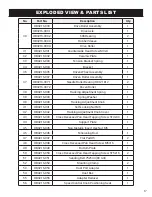
SAFETY INFORMATION
4
WARNING:
Dust generated from certain materials can be hazardous to your health. Always
operate the tool in a well-ventilated area and provide for proper dust removal. Use dust collection
systems whenever possible.
WORK AREA SAFETY
1. Keep work area clean and well lit. Cluttered or dark areas can cause accidents. Do not work on floor
surfaces that are slippery with sawdust or wax.
2. Do not operate power tools in explosive atmospheres, such as in the presence of flammable liquids,
gases or dust. Power tools create sparks which may ignite the dust or fumes.
3. Keep bystanders at a safe distance from the work area. Never allow children or pets near the tool.
ELECTRICAL SAFETY
1. Do not expose power tools to rain or wet conditions. Water entering a power tool will increase the risk
of electric shock.
2. Power tool plugs must match the outlet. Never modify the plug in any way. Modified plugs with
non-
matching outlets will increase the risk of electric shock.
3. Do not abuse the cord. Never use the cord for carrying, pulling or unplugging the power tool. Keep cord
away from heat, oil, sharp edges or moving parts. Damaged or entangled cords increase the risk of
electric shock.
4. Avoid body contact with earthed or grounded surfaces such as pipes, radiators, ranges and
refrigerators. There is an increased risk of electric shock if your body is earthed or grounded.
5. When operating a power tool outdoors, use an extension cord suitable for outdoor use. Use of a cord
suitable for outdoor use reduces the risk of electric shock.
6. If using a power tool in a damp location is unavoidable, use a ground fault circuit interrupter (GFCI)
protected supply. Use of a GFCI reduces the risk of electric shock.
PERSONAL SAFETY
1. Stay alert. Watch what you are doing and use common sense when operating a power tool. Do not
use a power tool while you are tired or under the influence of drugs, alcohol or medication. A moment
of inattention while operating power tools may result in serious personal injury.
2. Use personal protective equipment. Always wear safety goggles at all times that comply with ANSI
Z87.1. Use ear protection such as plugs or muffs during extended periods of operation. Wear a face
mask or dust mask to fight the dust produced by sanding operations.
3. Do not wear loose clothing, gloves, neckties, or jewelry (rings, watches, etc.) when operating the tool.
Inappropriate clothing and items can get caught in moving parts and draw you in. Always wear non-
slip footwear and tie back long hair.
4. Do not overreach. Keep proper footing and balance at all times. This enables better control of the
power tool.
Содержание HB3216
Страница 18: ...EXPLODED VIEW PARTS LIST 18 ...
Страница 20: ......





































